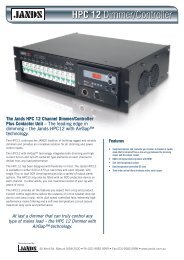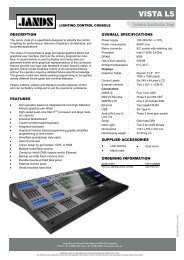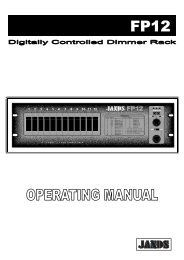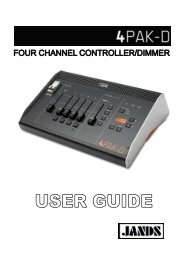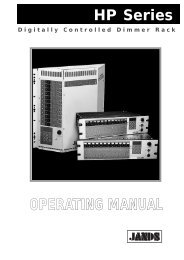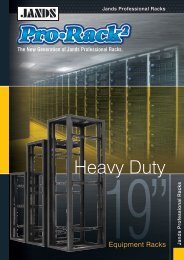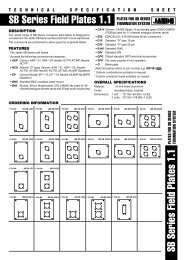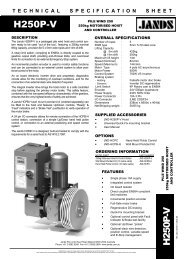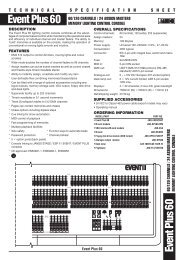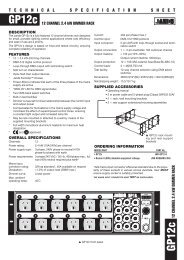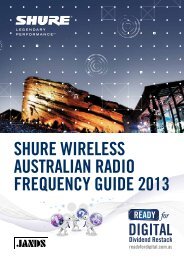A Guide to Quality Installed Sound Systems. - Jands
A Guide to Quality Installed Sound Systems. - Jands
A Guide to Quality Installed Sound Systems. - Jands
You also want an ePaper? Increase the reach of your titles
YUMPU automatically turns print PDFs into web optimized ePapers that Google loves.
speakers<br />
distributed<br />
Ceiling Mount<br />
JBL Control 226C/T<br />
When only the best will do. The ultimate 6.5” 2-way with<br />
integrated back can & grille.<br />
• 47Hz-19kHz<br />
• 150 watts program<br />
• 90dB (1W/1m)<br />
• 8 ohms<br />
• 120° conical<br />
• 226CT 70/100V taps: 60W, 30W, 15W, (7.5W 70v only)<br />
• 330 x 246mm (h x dia)<br />
JBL Control 227C/CT<br />
When only the best will do. The ultimate 6.5” coaxial with<br />
independent back can & grille.<br />
• 43Hz-19kHz<br />
• 150 watts program<br />
• 90dB (1W/1m)<br />
• 8 ohms (227C)<br />
• 120° conical<br />
• 227CT 70/100V taps: 68W, 34W, 17W, (8.5W 70v only)<br />
• 305 x 147mm (h x dia)<br />
JBL C300 12” Ceiling Speakers<br />
Premium high-fidelity performance for no compromise systems.<br />
328C – 8” coax 2 way<br />
• 45Hz-18kHz<br />
• 250 watts<br />
• 120° conical<br />
• 93dB (1w/1m)<br />
• 305 x 160mm (h x dia)<br />
Optional<br />
• MTC-300BB8 back box<br />
• MTC-RG6/8 grille<br />
321C – 12” coax 2-way<br />
• 34Hz-18kHz<br />
• 250 watts<br />
• 90° conical<br />
• 94dB (1w/1m)<br />
• 366 x 366mm square baffle<br />
• 223mm depth<br />
Optional<br />
• MTC-300BB12 back box<br />
• MTC-300SG12 grille<br />
328CT – As above with<br />
• 60W transformer<br />
• 60W, 30W, 15W, (7.5W 70v only)<br />
• 305 x 218mm (h x dia)<br />
321CT – As per 321C with<br />
• 60W transformer<br />
• 68W, 34W, 17W, (8.5W 70v only)<br />
• 366 x 366mm square baffle<br />
• 240mm depth<br />
312CS – 12” in-ceiling subwoofer<br />
• 30Hz-4.5kHz<br />
• 400 watts<br />
• 93dB (1w/1m)<br />
• 8 ohms<br />
• 366 x 366mm square baffle<br />
160mm depth<br />
TECH-TIPS<br />
What is the difference between constant voltage system (70v/100v) and ‘normal’ system?<br />
And why should I choose one over the other?<br />
Constant voltage systems step up the nominal voltage on the speaker line <strong>to</strong> a higher voltage, either 70v or 100v, <strong>to</strong> reduce the effects of cable losses.<br />
Constant voltage speakers present higher impedance <strong>to</strong> the line than ‘normal’ low impedance speakers. Higher impedance speakers draw less current<br />
from the amplifier, and since cable loss is proportional <strong>to</strong> current, cable losses are greatly reduced.<br />
For example, let’s consider two systems. System 1 is a traditional low impedance system. With 4 x 8 ohm loudspeakers connected <strong>to</strong> a 400w amplifier<br />
via 100m of 1mm2 speaker cable.<br />
Total speaker load = 8/4 = 2 ohms<br />
Loss on speaker cable = 9dB<br />
Power delivered <strong>to</strong> the speakers = 49w<br />
Speaker cable loss = 87%<br />
Wow, the majority of our amplifier power is being wasted heating up the speaker cable! Now let’s change <strong>to</strong> a constant voltage system feeding 4 x 100v<br />
speakers tapped at 100w each.<br />
Total speaker load = 100/4 = 25 ohms<br />
Loss on speaker cable = 1.2dB<br />
Power delivered <strong>to</strong> speakers = 303w<br />
Speaker cable loss = 24%<br />
You can see that the constant voltage system is far more efficient. In fact we would have <strong>to</strong> increase the speaker cable <strong>to</strong> 30mm2 in the first example <strong>to</strong><br />
even come close <strong>to</strong> the cable loss of the constant voltage system. That’s a BIG cable, we’re talking the stuff they use for welding cable!!!<br />
JBL Speakers Distributed – Ceiling Mount




